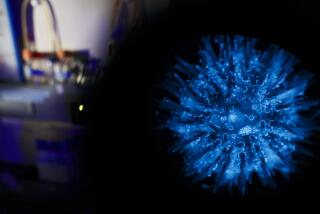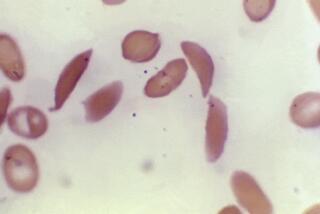Scientists use CRISPR to turn genes on without editing their DNA
- Share via
The revolutionary gene editing tool CRISPR-Cas9 is best known for helping scientists edit a strand of DNA more precisely and efficiently than ever before.
Now, researchers have demonstrated another use for the CRISPR complex: changing which genes are expressed without altering the genome itself.
For the first time, researchers at the Salk Institute in San Diego were able to use CRISPR to activate beneficial genes in live mice suffering from muscular dystrophy, Type 1 diabetes and acute kidney injury.
In more than 50% of test cases, the animal’s health improved after the CRISPR intervention, according to a study published Thursday in the journal Cell.
Previous work already had demonstrated that CRISPR could be used to alter gene expression in cells in a petri dish, but the new study represents the first time the technique has worked in a live animal, the scientists said.
The feat is significant.
“We moved this technique one big step toward human therapy,” said Hsin-Kai Liao, a postdoctoral researcher at Salk and co-first author on the paper.
Alexis Komor, a biochemist at UC San Diego who was not involved with the work, agreed. “This is a really thorough in vivo study that begins to bridge the gap between using CRISPR-based tools in cells in a dish and using them translationally,” she said.
CRISPR-Cas9 has been described as the Swiss Army knife of gene editing because it performs several different functions.
To start, it works like a search button on your word processor. Scientists can easily program it to find a specific string of letters in a DNA sequence.
Once it finds those letters, the complex morphs into a pair of molecular scissors. An enzyme, usually Cas9, binds to the chosen region and makes a two-stranded break in the DNA’s double helix.
To replace a faulty gene with a functioning one, scientists also attach a string of DNA to the CRISPR complex. The hope is that the cell will use the new DNA to repair the cut to its genome.
This works a lot of the time but not all of the time, and it can lead to accidental deletions or insertions in the genetic code.
To circumvent this danger, researchers have experimented with using a handicapped version of the CRISPR-Cas9 system to deliver instructions that turn a specific gene on or off.
In this version of CRISPR, the Cas9 enzyme is deactivated. It still can bind to DNA, but it can’t make a cut. Instead, it brings molecules along with it that can tell the cell it is time to activate a particular gene.
Aside from removing the possibility that mutations will make their way into the genome, other advantages of this technique are that it’s impermanent and adjustable, said Juan Carlos Izpisua Belmonte, a developmental biologist at Salk and the principal investigator on the paper.
It also mimics the process that cells already use to tell their genes to turn on.
“This is very close to what a cell normally does to activate a gene, so it’s not abnormal what’s happening,” he said.
Scientists have been trying to use CRISPR to give a cell marching orders since at least 2013. But it wasn’t until now that anyone was able to make it work in a live animal.
The challenge, scientists said, was working out the delivery system.
Researchers often use a virus to insert new material into cells of living animals. However, this transport system has a size limit. It works only with relatively small molecules. The instructions that scientists used to activate genes on cells in a petri dish were too large to be transported by the virus.
To overcome this hurdle, the researchers separated the Cas9 from the instructions. They inserted the Cas9 into the cell with one virus and the marching orders with another one.
It took about four years of trial and error, but eventually they were successful.
Fumiyuki Hatanaka, a postdoctoral researcher at Salk and the other first author on the paper, recalled the first time he saw the physical results of his experiments. He was working with mice with weakened muscles to see whether he could use the systems to turn on genes that would promote muscle growth.
“The first time we saw the muscle change, it was very obvious from the outside,” he said. “I remember I was really excited because nobody had ever demonstrated this phenotype in an animal before.”
Belmonte said the whole lab was thrilled.
“It was an important moment,” he said.
Over the following months, the research team used its system to treat mice with other ailments, such as acute kidney injury, Type 1 diabetes and muscular dystrophy.
There is still much work to be done before this method can be used in human patients, however. Researchers said the next step is to see how it works in larger animals. Also, the safety of the system will need to be tested repeatedly.
“Our final goal is treatment of disease, so we want to make sure this technique is really working,” Hatanaka said.
Komor said the work is exciting, but she noted that the end result would be a disease treatment, rather than a cure.
“So a patient would likely require repeated treatments depending on the particular disease,” she said.
The benefit, though, is that the treatments can be tailored to a specific individual, the study authors said.
They also said their technique can be used on many diseases, including Alzheimer’s and perhaps the aging process overall.
“When you do a medical act, you try to help, not hurt,” Belmonte said. “If we don’t cut the genome, we don’t introduce a problem, and that is the main advantage of this technique.”
Do you love science? I do! Follow me @DeborahNetburn and “like” Los Angeles Times Science & Health on Facebook.
MORE IN SCIENCE
Widespread screening for breast cancer didn’t do much to save women’s lives, study finds







